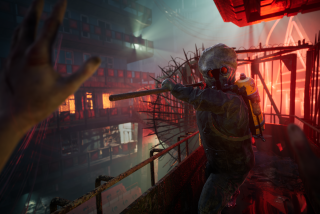Software Companies Looking to Sequels for New Crop of Successful Titles
- Share via
ATLANTA — Show me.
That ought to be the slogan for the annual Electronics Entertainment Expo, the big, bright, noisy digital trade show that begins here today. As hundreds of exhibitors hype thousands of new products over the next three days, the only thing other than a headache a visitor can count on is that most of what’s being promoted as this year’s “next best thing” will look and play a lot like last year’s “next best thing.”
None of the top video game hardware manufacturers plan to unveil any new machines at E3, so the emphasis will be stronger than ever on software. Computer game makers are expected to showcase new titles developed especially for stronger, faster multimedia machines. At the same time, console developers are feeling the pressure to push the limits of aging 32-bit machines and to get a strong flow of titles running for Nintendo’s 64-bit rig.
Although a few companies at the show boast a few promising titles, much of what’s on tap for the next 18 months looks to be faster, crisper and louder knockoffs of tried and true genres like first-person shooters, side-scrolling adventures, fighters and, of course, plenty of sequels to hot games.
Consider Sony’s Crash Bandicoot 2, Sega’s ports of the PC’s Duke Nukem and Quake and Nintendo’s port of Hexen. PC players looking for the new won’t fare much better with titles like Tomb Raider 2, Mechwarrior III, Hexen II and Dark Forces II.
To be sure, all of these games will probably look and play great at the show and will no doubt end up being big sellers when they hit store shelves in coming months. For instance, early screen shots of Tomb Raider 2 and Crash Bandicoot 2 look beautiful. That’s not the point, though. As the industry grows, creativity has not kept pace. While technically sharper than anything previous, the current crop of titles across platforms lacks the kind of flair and ingenuity that has historically marked the game business.
What’s the problem? Success, in a way. A cyclical business, the video and computer game industry has enjoyed unprecedented growth over the past several years and most analysts expect the trend to continue. The result: Big business aggressively takes more of a role than the garage-based software companies that once dominated game development. And with average game costs rising to between $1.3 million and $2 million, the risk of a flop is more costly than it’s ever been.
The annual State of the Entertainment Software Industry report by the Interactive Digital Software Assn. suggests that the trend in the interactive industry mirrors the consolidation that occurred within the film industry. The likely outcome threatens to be similar, too: an unsatisfying gruel of pretty games that are tough to tell apart.
There is hope, though. Mindscape’s Adventures on Lego Island for the PC promises to be a winner. So does Starfox 64 for Nintendo’s machine and a few titles on PlayStation and Saturn like Blasto and Sonic R. In addition, dozens of third-party developers for consoles and PCs have promised to unveil some slick new titles.
Let’s hope so. The challenge of E3 will be to find the real diamonds among so much costume jewelry. If the future of electronic games will truly be as bright as company honchos hope, they need to deliver the kind of creative and challenging games players demand.
Show me.
Staff writer Aaron Curtiss reviews video games every other Thursday. To comment on a column or to suggest games for review, send letters to The Times, 20000 Prairie St., Chatsworth, CA 91311. Or send e-mail to Aaron.C[email protected]






